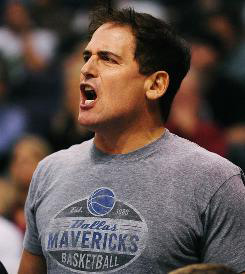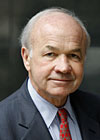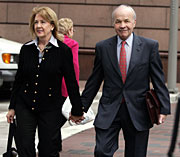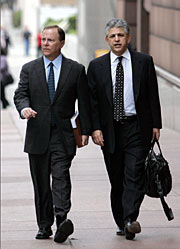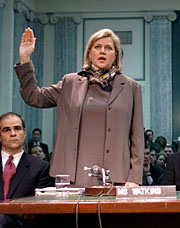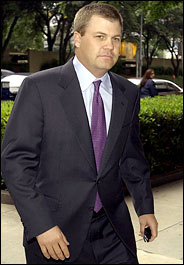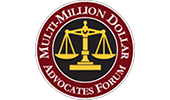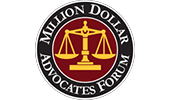News
- Court revives SEC’s insider-trading lawsuit vs. Mark Cuban
- Trial judge vacates conviction of late Enron founder Lay
- Defense: Politics behind Brocade charges
- Act 2: Enron’s Skilling and Lay to take the stand
- Watkins set to take the stand today
- A Dream Comes to Earth in a Houston Courtroom
- AIG in deeper legal trouble if records were destroyed
- Jury Indicts Lay, Former Head of Enron
- Critical decisions await Tyco judge
- PROSECUTING MARTHA STEWART: THE GOVERNMENT; Prosecutors Have Reasons for Stalking Celebrities
- Stewart pleads innocent to fraud, conspiracy charges
-
Court revives SEC’s insider-trading lawsuit vs. Mark Cuban
Dallas Mavericks owner Mark Cuban reacts during the second half of a basketball game against the Phoenix Suns in January 2010.
By Matt Krantz, USA TODAY
A federal Appeals Court reopened an insider-trading case against outspoken billionaire Mark Cuban Tuesday, deciding there’s enough evidence of potential wrongdoing to warrant the Securities and Exchange Commission’s lawsuit to go forward.The SEC charged Cuban in November 2008 with using insider information to avoid a $750,000 loss in June 2004. Cuban, the owner of the NBA’s Dallas Mavericks, sold his 6.3% stake in Mamma.com after the search engine’s CEO told him it planned to sell additional stock at terms that were unfavorable to existing shareholders, the SEC says.
A U.S. District Court dismissed the lawsuit in July 2009, supporting Cuban’s assertion that while he may have agreed to keep the information confidential, he said nothing about whether he could trade on the information.
READ THE LAWSUIT: SEC vs. Mark Cuban
The Appeals Court, though, rejected the lower court’s support of Cuban’s assertion, says Gregory Lawrence, attorney at Conti Fenn & Lawrence, when it said in its decision: “Under Cuban’s reading, he was allowed to trade on the information but prohibited from telling others – in effect providing him an exclusive license to trade on the material non-public information.”The appellate court’s decision also raises issue with Cuban’s initial reaction to the conversation he had with the Mamma.com CEO, when Cuban said, ” ‘Well, now I’m screwed. I can’t sell,’ ” says Christopher Bebel of the Christopher Bebel law firm.
“Cuban’s own language,” Bebel says, “is a crucial piece of evidence that supports the SEC’s theory of the case.” He adds that Cuban’s impromptu comment showed the information was relevant to his opinion of the stock.
Furthermore, the Appeals Court in its decision highlighted a phone call that Cuban made to Merriman Curhan Ford, the investment bank handling the additional issuance of stock. During the eight-minute call, the Merriman representative gave Cuban additional information about the planned offering. The conversation showed Cuban “was on a mission to solidify his determination to sell,” Bebel says.
Separately Tuesday, Cuban’s lawsuit against the SEC to recoup his legal fees was denied pending the outcome of the insider-trading charges against him.
Cuban’s attorneys, Chris Clark and Stephen Best of Dewey & LeBoeuf, said they would have liked the case to have ended, but said the Appeals Court supports their assertion that the SEC must show Cuban had a duty to not trade.
In a statement, SEC spokesman John Nester said, “We are pleased with the court’s decision and look forward to presenting our case.”
The case’s return is a setback for Cuban, Bebel says. Cuban has been a long-standing critic of stock investing, pointing to how investors are shortchanged, writing on his blog, “The stock market is still for suckers.”
-
Trial judge vacates conviction of late Enron founder Lay
LAY | Getty Images
By Greg Farrell, USA TODAY
The late Ken Lay, the Enron founder who was convicted in May of deceiving investors about Enron’s finances, is once again innocent in the eyes of the law.U.S. District Judge Sim Lake, who presided over the trial of Lay and his colleague Jeff Skilling in Houston earlier this year, issued an order Tuesday vacating Lay’s conviction and dismissing the indictment against him.
“The court concludes that Lay’s conviction must be vacated,” wrote Lake in a 13-page opinion. “The indictment against Kenneth L. Lay is dismissed.”
Ever since Lay died of a heart attack in Aspen, Colo., July 5, following his conviction at trial but before he had the chance to appeal the verdict, Lake’s ruling has been widely expected. As a matter of law, a conviction against a criminal defendant is not final until the defendant has had the chance to appeal the verdict. Therefore, Lay’s death short-circuited the full legal process to which he was entitled.
“Mr. Lay never had the chance to appeal,” said Sam Buffone of Ropes and Gray, who represented the estate of Ken Lay. “We were eager to appeal.”
Prosecutors fought an uphill battle against Lake’s decision, arguing last month that he should postpone his ruling until Congress had the chance to pass a new law changing the ground rules for defendants who died before getting a hearing before an appellate court. But Congress never seriously considered the new law.
The ruling is a boost for members of Lay’s family, who no longer face criminal forfeiture proceedings by the Department of Justice. After Lay was found guilty in May, Justice took steps to track down and seize $40 million from Lay, even though he testified in his trial that he was virtually bankrupt.
Justice, which plans to pursue forfeiture in civil proceedings, issued the following statement Tuesday: “Today’s ruling does not change the fact that Mr. Lay was found guilty after a four-month jury trial and a separate bench trial. We will continue to pursue all remedies available for restitution on behalf of the victims of the fraud at Enron.”
As for Skilling, Lay’s co-defendant, the ruling has no impact. In May, jurors convicted Skilling, who served as CEO of Enron in 2001, of 18 separate criminal charges. He is slated to be sentenced on Monday.
When Lay died in July, some Houston residents and former Enron shareholders vented their rage that he had escaped a prison term. Many, on the Web and on talk radio, demanded an autopsy. But an autopsy conducted in Aspen showed that Lay did indeed have heart problems, and that he died of natural causes.
Despite the dismissal of the indictment against Lay, some observers believe the former Enron CEO will never escape the shadow of his role in Enron’s collapse. “He’s innocent with an asterisk,” says Christopher Bebel, a Houston attorney who followed the case closely. “History will accurately record this episode, and the slate will not be wiped clean. When future generations look back, they will look at it as a situation where guilty verdicts were reached. A massive indictment was brought after $60 billion in market valuation evaporated, and a jury held him accountable.”
Defense: Politics behind Brocade charges
By Edward Iwata, USA TODAY
The attorney for former Brocade Communications CEO Gregory Reyes, charged with fraud in the federal government’s nationwide crackdown against suspected stock-option accounting abuse, says prosecutors and regulators are pressing forward on a weak case for political reasons. In a written statement, Richard Marmaro of the Skadden Arps law firm accused the Justice Department and Securities and Exchange Commission of playing politics and filing charges based on “some perceived need to show quick action in response to the stock-option issues being discussed in the media.”Marmaro added: “When the evidence comes out in court, Mr. Reyes will unquestionably be found innocent, and everyone will wonder why the government charged him in the first place.”
Patrick Murphy, the SEC’s enforcement chief in San Francisco, said: “Our case is based upon the facts. We think there’s clear evidence that backdating occurred, that the defendants knew it.”
U.S. Attorney’s Office spokesman Luke Macaulay said: “This case is moving forward based on the strength of the evidence.”
The issue of political motivation arises often in criminal cases, but, “It rarely gets any traction,” says Christopher Bebel, a former SEC attorney in Houston. Judges typically bar evidence of that kind, he says.
Federal officials on Thursday charged Reyes and former Brocade human resources vice president Stephanie Jensen with criminal and securities fraud. Former Brocade chief financial officer Antonio Canova was charged with securities fraud. Attorneys for Jensen and Canova have also denied the charges.
The complaints were among the first charges to be brought against executives suspected of stock-option accounting manipulation. Federal officials are investigating 80 U.S. companies, and Justice Department and SEC officials say they plan to file more charges.
In the Brocade case, Marmaro also said that “financial gain is always a motive in securities fraud cases, and here, there was none.” He said the government has not alleged that Reyes “made any money through the alleged option irregularities” or even “granted himself any of the options at issue.”
Scott Balber, an attorney at Chadbourne & Parke in New York who is uninvolved in the case, says that “one problem the government clearly has is that nobody benefited financially from the backdating.”
Reyes did legally sell hundreds of millions of dollars of Brocade stock over several years. But that won’t look good to jurors in an era of corporate scandals and high CEO pay, says Andrew Stoltmann, a Chicago attorney at Stoltmann Law Offices, which is uninvolved in the case.
It’s not illegal to backdate stock options. But companies must disclose it to the SEC, and cannot manipulate the dates of grants to increase their value.
-
Defense: Politics behind Brocade charges
By Edward Iwata, USA TODAY
The attorney for former Brocade Communications CEO Gregory Reyes, charged with fraud in the federal government’s nationwide crackdown against suspected stock-option accounting abuse, says prosecutors and regulators are pressing forward on a weak case for political reasons. In a written statement, Richard Marmaro of the Skadden Arps law firm accused the Justice Department and Securities and Exchange Commission of playing politics and filing charges based on “some perceived need to show quick action in response to the stock-option issues being discussed in the media.”Marmaro added: “When the evidence comes out in court, Mr. Reyes will unquestionably be found innocent, and everyone will wonder why the government charged him in the first place.”
Patrick Murphy, the SEC’s enforcement chief in San Francisco, said: “Our case is based upon the facts. We think there’s clear evidence that backdating occurred, that the defendants knew it.”
U.S. Attorney’s Office spokesman Luke Macaulay said: “This case is moving forward based on the strength of the evidence.”
The issue of political motivation arises often in criminal cases, but, “It rarely gets any traction,” says Christopher Bebel, a former SEC attorney in Houston. Judges typically bar evidence of that kind, he says.
Federal officials on Thursday charged Reyes and former Brocade human resources vice president Stephanie Jensen with criminal and securities fraud. Former Brocade chief financial officer Antonio Canova was charged with securities fraud. Attorneys for Jensen and Canova have also denied the charges.
The complaints were among the first charges to be brought against executives suspected of stock-option accounting manipulation. Federal officials are investigating 80 U.S. companies, and Justice Department and SEC officials say they plan to file more charges.
In the Brocade case, Marmaro also said that “financial gain is always a motive in securities fraud cases, and here, there was none.” He said the government has not alleged that Reyes “made any money through the alleged option irregularities” or even “granted himself any of the options at issue.”
Scott Balber, an attorney at Chadbourne & Parke in New York who is uninvolved in the case, says that “one problem the government clearly has is that nobody benefited financially from the backdating.”
Reyes did legally sell hundreds of millions of dollars of Brocade stock over several years. But that won’t look good to jurors in an era of corporate scandals and high CEO pay, says Andrew Stoltmann, a Chicago attorney at Stoltmann Law Offices, which is uninvolved in the case.
It’s not illegal to backdate stock options. But companies must disclose it to the SEC, and cannot manipulate the dates of grants to increase their value.
-
Act 2: Enron’s Skilling and Lay to take the stand
Former Enron CEO Ken Lay and his wife Linda are set for the defense to present their case next week.
By Greg Farrell, USA TODAY
After nine weeks, prosecutors from the Enron Task Force paraded rested their case alleging Ken Lay and Jeff Skilling conspired to hide the true state of the company’s finances from the investing public. Starting Monday in Houston, defense lawyers will present the other side. The heart of their case is expected to come when Skilling and Lay take the stand.Monday, Act 2 begins.In the first act, which began nine weeks ago, prosecutors from the Enron Task Force paraded more than 20 witnesses before the jury in an effort to prove that Lay and Skilling conspired to hide the true state of the company’s finances from the investing public.
Most of those witnesses alleged that either Skilling or Lay knew Enron was in bad financial shape in the months leading up to its collapse into bankruptcy in December 2001. (Key witnesses: What they’ve testified to)
Legal experts who have followed the trial say the government presented a strong case, and Lay and Skilling now face a difficult, though not insurmountable, challenge in their efforts to win acquittal.
“The defense must do everything possible to dig their clients out of the massive hole the government has dug,” says Christopher Bebel, a Houston attorney who has attended part of the trial. “The odds of a conviction have steadily mounted throughout the course of the trial as prosecutors have piled one brick on top of another while buttressing and corroborating the statements of key witnesses.”
Starting Monday in Houston, defense lawyers will present the other side. The heart of their case, and the highlight of the trial, is expected to come when Skilling and Lay take the stand on their own behalf.
Defense lawyers will call more than a dozen witnesses to testify about the defendants’ character, Enron’s accounting and the turbulent market conditions that hastened the company’s collapse. But it could be the highly anticipated testimony of Lay and Skilling that ultimately determines the outcome of the trial.
Usually, it’s a bold and risky move for defendants to testify in white-collar criminal trials, but in this case, Lay and Skilling have little choice. The government has accused them of heading a conspiracy to prop up Enron’s earnings, a plot that included nearly 100 unindicted co-conspirators.
The defendants would love to call a stream of these alleged co-conspirators to testify that everything they did at Enron was legal and that Lay and Skilling wanted what was best for shareholders, Bebel says. But it won’t happen. Anyone tagged with the “unindicted co-conspirator” label won’t be setting foot in the federal courthouse in Houston unless it’s to invoke their Fifth Amendment right against self-incrimination.
“We have been extremely handicapped because a number of critical witnesses have refused to testify,” says Daniel Petrocelli, Skilling’s lead attorney. But Petrocelli, who seems to have established a rapport with the jury, plans to stick to a theme he has pushed since opening arguments, when he declared “everyone’s entitled to their opinions, but not their own facts.”
By Pat Sullivan, AP Former Enron executive Jeff Skilling, left, and attorney Daniel Petrocelli start presenting their case Monday.
Throughout the trial, when cooperating witnesses testified that they thought Skilling was lying, Petrocelli, who paces in front of the jury box like a panther, has pounced on their statements, demanding how they could possibly know something was a lie without getting inside his client’s head.
His counterpart on Lay’s defense team, Mike Ramsey, has been noticeably less mobile in court, sparking some discussion among spectators as to whether he was feeling healthy. Ramsey addressed that question Tuesday, when he acknowledged that a blockage had been discovered in one of his coronary arteries last week. Doctors cleared the blockage and inserted a stent to keep the artery open.
Now that it’s their turn to put on a show, Petrocelli and Ramsey will pin their hopes for victory on their clients’ ability to perform in front of the jury.
“Lay will have to be a one-man wrecking crew in order to salvage an acquittal, and the same with Skilling,” Bebel says. “The deck is stacked against them, because Lay has to contradict a handful of witnesses, and Skilling has to contradict even more.”
Legal experts who have been following the trial closely credit the government with doing a good job of presenting a complex series of facts to jurors in an easy-to-understand way.
“The government’s case was coherent and made sense and was put in terms that the jury should be able to understand,” says Philip Hilder, a Houston attorney who represents one of the government’s witnesses, internal whistle-blower Sherron Watkins.
It didn’t hurt that the government argued its case before U.S. District Judge Sim Lake, an experienced, no-nonsense jurist who made it clear that he didn’t want to waste the jury’s time. Lake’s insistence on starting on time every day, and his constant reminders to prosecutors and defense lawyers to stay focused have been a boon to the government, at least so far.
“It’s been a very successful Act I,” says John Coffee, an expert in securities law at Columbia University. “This trial is being run by a skilled and experienced judge. Given what can go wrong in a trial, nothing has gone wrong. The trains are running on time. From a prosecution standpoint, you need the trains to run on time. The moment a jury begins to not understand things, they become suspicious and resentful.”
The government’s case
The collapse of Enron – once the nation’s seventh-largest U.S. corporation – wiped out more than $60 billion in market capitalization, cost thousands of Houston residents their jobs and ruined the retirement savings of many others.
In the past four years, federal investigators, plaintiffs’ lawyers, bankruptcy examiners and journalists have been picking over the debris of the company’s collapse, trying to determine the root causes of Enron’s failure and, in the case of the Enron Task Force, to assign criminal blame for the debacle.
In this trial, the task force has avoided pitfalls that can hobble securities fraud cases. The story of Enron’s implosion involves complex accounting maneuvers that the company used to maximize its reported earnings, but prosecutors have steered clear of almost all references to those accounting issues, fearing they might lose the jury.
Instead, they took a simple approach, arguing that Lay and Skilling knew Enron was misrepresenting earnings. Prosecutors brought in eight cooperating witnesses who had pleaded guilty to Enron-related crimes. They and others testified that Lay and Skilling knew Enron was in trouble in 2001, even as the CEOs touted it as a model of robust health to investors and analysts. The government’s case broke down into several easy-to-follow allegations:
– Skilling lied about Enron Broadband Services’ earnings. According to prosecutors, Skilling told Wall Street analysts that broadband was hitting its earnings targets. Enron’s stock surged on announcements about broadband’s success, with analysts believing that the division would revolutionize the marketplace for fiber-optic communications just as Enron had revolutionized the energy market a decade earlier.
Government witnesses, including the men who ran the division, testified that broadband’s business was moribund. Ken Rice, former head of broadband, testified that the only reason it was able to report revenue for a given quarter was by selling unused fiber to a partnership controlled by former CFO Andrew Fastow.
– Skilling lied about Enron Energy Services’ earnings. Like the broadband division, EES was a relatively new division that was supposed to fuel the company’s growth. But former EES chief David Delainey testified that the unit was bleeding red ink.
To disguise the losses, Delainey testified that Skilling authorized the shift of most EES operations to Enron North America, a profitable division that could absorb the losses without exposing the weakness of the unit.
– Skilling encouraged sleight-of-hand accounting transactions. In what proved to be the most anticipated portion of the government’s case, former CFO Fastow testified that Skilling encouraged him to “juice” the company’s earnings by forming private partnerships that could trade with Enron.
Time and again, Enron relied on last-minute deals with Fastow’s LJM partnerships to hit its quarterly earnings targets. Fastow said he had a verbal guarantee from Skilling that his LJM funds would never lose money, even when LJM overpaid for weak Enron assets.
Lay ignored warnings that Enron’s business was sinking. In August 2001, Skilling resigned as CEO, and Lay, who was chairman, took over the job. Fastow said he warned Lay that Enron would have to write down the company’s international assets by as much as $5 billion. A few months later, he said he warned Lay that Enron was entering a “death spiral.” Nevertheless, Lay continued to talk up Enron’s stock and its growth prospects before employees and analysts.
Paula Rieker, who worked in investor relations at Enron, also testified that Lay continued to tout Enron’s earnings strength to outsiders, even when internal discussions focused on the company’s troubles.
Reasonable doubt
Despite the stream of witnesses pointing the finger at Lay and Skilling, the government’s case isn’t a slam-dunk. “The defense case is difficult, but not impossible,” says Jamie Wareham, global chairman of litigation at Paul Hastings, a law firm. “It’s always been a reasonable doubt case.”
Defense lawyers plan to hammer away at several weak spots when they present their case:
– The government didn’t produce “smoking-gun” documents. Despite an intense four-year investigation, prosecutors never found e-mails or memos from Lay or Skilling indicating they were aware they were deceiving the marketplace.
– Auditors and lawyers signed off on all of Enron’s questionable transactions. Despite Fastow’s testimony about how Enron used his LJM partnerships to “juice” earnings, Skilling’s lawyers say they will show that Arthur Andersen gave its approval to all Enron transactions with Fastow’s funds. Lawyers from Vinson & Elkins also signed off on the deals.
– Enron’s wholesale trading division really was profitable. Prosecutors inundated the jury with testimony about bogus earnings at Enron’s broadband and retail divisions, but there’s no question that Enron’s primary business, the trading of energy contracts, was immensely profitable. Defense lawyers will argue that even if some of Enron’s divisions lagged behind, the company as a whole was still profitable, just as Lay told the public in the fall of 2001.
“They’re going to try to prove that all the transactions were legal,” Wareham says.
But that’s where the defense could get in trouble, says Columbia’s Coffee. It would be almost impossible to convince 12 jurors from the Houston area that criminal behavior at Enron was limited to Fastow’s embezzlement of funds.
“The opening statement took the incredible position that there was no problem at Enron,” he says, “that anything hidden was done by Andy Fastow and he cheated us, we’re the victims. That’s a fatal error, equivalent to denying the Holocaust.”
-
Watkins set to take the stand today
Sherron Watkins wrote a memo warning that Enron could “implode” from accounting misdeeds.
By Greg Farrell, USA TODAY
But when the former Enron vice president takes the stand Wednesday as a prosecution witness in the government’s trial of former Enron CEOs Ken Lay and Jeff Skilling, she’ll no longer be alone.Instead, the woman who is perceived as the lone truth-teller in a company built on lies will come before jurors as one of many witnesses in the prosecution’s case against Enron’s top management. (Watkins memos: August 2001 memo to Ken Lay | October 2001 memo)
In the summer of 2001, Watkins joined Chief Financial Officer Andrew Fastow’s global finance group. A former accountant at Arthur Andersen, she soon learned the secret to Enron’s success: a bogus accounting gimmick that allowed the company to hide hundreds of millions of dollars in losses from investors.
Scores of executives, lawyers and accountants had approved the company’s financial statements. But Watkins realized immediately that the company couldn’t hedge its losses with partnerships that were capitalized with Enron’s own stock.
After Jeff Skilling resigned abruptly as CEO that August, she wrote her now famous anonymous memo, warning Lay that Enron could “implode in a wave of accounting scandals.” A few days later, she came forward and met with Lay, now chairman and CEO.
Thinking that Lay had been duped by Skilling and others, she urged him to get an outside law firm to review the transactions approved by Enron’s auditors at Andersen and the company’s lawyers at Vinson & Elkins.
When Fastow learned that Watkins had gone behind his back to complain to Lay, he was furious. Watkins eventually told a congressional committee that she feared for her safety.
When Watkins met with Lay again in October, she urged him to fire Andersen and Vinson & Elkins, restate Enron’s earnings, and blame Skilling and Fastow.
Lay didn’t do that, and Enron wound up in Chapter 11 bankruptcy protection. Watkins eventually became one of Time magazine’s persons of the year for 2002, and she co-authored a book about her experience at Enron, Power Failure.
Witness for the prosecution
Watkins is expected to testify about her conversations with Lay. Through the first six weeks of the trial, prosecutors have introduced a parade of cooperating witnesses who have implicated Skilling, but it wasn’t until last week, when Fastow testified that he warned Lay repeatedly of Enron’s financial problems, that the government did any real damage to Lay.
“Sherron Watkins will testify that she told Lay Enron was a house of cards,” says John Coffee, an expert in securities law at Columbia University. “She is going to be a bridge from Fastow, who is not the most reliable or credible witness.”
Defense lawyers are expected to remind jurors that auditors and lawyers approved all of Enron’s accounting transactions. They’re also likely to point out that Watkins sold $48,000 worth of stock after meeting with Lay and advising him of the accounting problems.
On the questionnaire all prospective jurors fill out, at least one of those chosen said she admired Watkins’ bravery in writing to Lay. According to a court transcript, the unidentified juror said she could be open-minded about Watkins’ testimony, but knew how women were sometimes treated at big companies.
“I know how it is with a woman in the corporate world,” she told Judge Sim Lake during jury selection.
Lay’s lawyer is “going to have to be diplomatic,” says Christopher Bebel, a former federal prosecutor. “If someone’s up there, and he’s 280 pounds and he wears a leather jacket that says Hell’s Angels, you can be pretty tough, but if you’ve got Mother Teresa on the stand, you’ve got to be balanced.”
-
A Dream Comes to Earth in a Houston Courtroom
By ALEXEI BARRIONUEVOBrett Coomer/Getty Images
HOUSTON, Feb. 7, 2006 – From fast cars to rugged adventure trips to $6.4 million in bonuses, Enron was a dream maker for Kenneth D. Rice.
While he was still in his 30′s, Mr. Rice, a former Nebraska farm boy and high school jock, pocketed millions of dollars working for the Houston-based energy company. He lived life in the fast lane – literally – racing Ferraris and going on daredevil expeditions to southern Mexico and the Australian Outback with his onetime friend and mentor, Jeffrey K. Skilling, Enron’s former chief executive.
But as early as Wednesday afternoon, a different Ken Rice will take the stand in the criminal trial of Mr. Skilling and Kenneth L. Lay, who was chief executive when Enron collapsed in late 2001. Mr. Rice will testify against Mr. Skilling, who once considered him one of his most loyal supporters in transforming Enron from a staid pipeline company into a cutting-edge trading company with big ambitions. Mr. Skilling helped make Mr. Rice a very wealthy man. His total compensation, including stock sales, in 2000 came to $47.3 million – more than his bosses, Mr. Lay and Mr. Skilling, earned. Mr. Rice spent some of that money on sports cars, motorcycles and a Colorado vacation home.
But these days, Mr. Rice, 47, is a humbled government witness, having pleaded guilty in 2004 to one count of securities fraud for falsely promoting the troubled broadband division that he headed for two years. He faces up to 10 years in prison and is named in at least 32 pending civil lawsuits, with each of them having the potential to bankrupt him.
The government froze his bank accounts holding some $13.7 million; seized his former wife’s platinum, diamond and sapphire jewelry; and put protective orders on his Telluride, Colo., home and a 1995 Ferrari.
In many ways, Mr. Rice is a fitting allegory for Enron’s ambitious executives, who rose rapidly in an orgy of fast money and lavish perks, only to come crashing down, some into the waiting arms of government prosecutors eager to build a case against the company’s top managers.
Mr. Rice “embodied the traits that cartoonists have seized upon while characterizing Enron executives,” said Christopher Bebel, a former federal prosecutor. “They were driven in professional life by blind ambition and a penchant for an unending wave of personal luxuries.”
In building its case against Mr. Lay and Mr. Skilling, the government has obtained 16 guilty pleas from former Enron managers, including Mr. Rice, and has cast its net to include more than 100 unindicted co-conspirators. But few witnesses in the government’s lineup had the kind of access to Mr. Skilling’s thought processes and moments of unguarded candor as Mr. Rice, outside legal analysts said.
The confrontation between the old friends is expected to offer some of the first riveting moments in the trial, which began last week. Mr. Rice could be critical to proving the government’s case that Mr. Skilling participated in a sophisticated conspiracy to manipulate earnings and defraud Enron, and then lied about it to the investing public while enriching himself through insider stock sales.
Mr. Lay is also charged with conspiracy and fraud, principally for lying to investors about the health of Enron’s businesses in the last few months before Enron imploded in what was the largest bankruptcy at the time.
Prosecutors will use Mr. Rice to try to show that Mr. Skilling “acted as the ringleader” in urging him to lie about the state of Enron’s broadband network to pump up the company’s stock, Mr. Bebel said.
“It will be Rice’s task,” he said, “to establish that Skilling was driving the train on this issue, and it was Skilling who was responsible for the ultraoptimistic projections.”
The broadband allegations are among the most serious facing Mr. Skilling and Mr. Lay. Mr. Skilling made a cameo appearance last year in the courtroom where five executives from Enron’s broadband division were on trial, just days before Mr. Rice was due to testify. The judge in the case ordered Mr. Skilling out. His lawyer, Daniel Petrocelli, later said that Mr. Skilling had a “very deep interest” in the proceedings.
But if Mr. Rice is to be persuasive, he will have to avoid the kind of confusion he displayed in last year’s broadband trial. Testifying on behalf of the government, Mr. Rice incorrectly testified that an unedited video featuring Mr. Skilling had been shown at a January 2000 conference of stock analysts. The trial ended badly for the government last July, with jurors failing to convict any of the five defendants, returning a patchwork of acquittals and deadlocked verdicts.
Mr. Rice could not be reached for comment for this article. Two of his lawyers, William D. Dolan III and Jacks C. Nickens, did not return phone calls seeking comment.
Prosecutors pressured Mr. Rice to plead guilty in part after discovering that he booked profits of $40.3 million from stock transactions in 2000 and 2001. More than $9 million of that came from three trades on July 13, 2001, about a month before Mr. Skilling officially resigned from Enron, according to records from the Securities and Exchange Commission, and around the same time that Mr. Skilling privately told Mr. Lay of his intention to resign, according to earlier testimony by Mark E. Koenig, the former head of investor relations for Enron.
Mr. Rice joined Enron’s predecessor company, InterNorth, in the early 1980′s, and moved to Houston in 1985 when it merged with Houston Natural Gas to form Enron. Mr. Skilling came on board in 1990. Mr. Rice made his name – and won Mr. Skilling’s admiration – by securing a 20-year contract to provide natural gas for a power plant in Oswego, N.Y., run by Sithe, an international operator of utility plants. The deal was later criticized when the cost of natural gas more than doubled years after the contract was signed. But in Enron’s fast-moving culture, closing a deal was everything. And Mr. Rice became one of the best closers around.
The friendship between Mr. Rice and Mr. Skilling grew stronger from a shared fondness for outdoor adventure trips. Mr. Skilling took Mr. Rice and other favorite employees, including Andrew S. Fastow, the chief financial officer, on a motorcycle trip across 1,000 miles of Baja desert in Mexico, and later on a fly-fishing trip to Patagonia.
Mr. Rice also developed a fascination with car racing, competing in a Ferrari Challenge series geared to nonprofessionals who could afford the customized cars. Fast cars became so popular at Enron that at one management retreat in November 2000 outside San Antonio, a race along country roads was offered as an activity, along with golf, tennis and spa treatments, said two former senior managers. Mr. Rice and several other executives brought their own Ferraris and Porsches.
In his carefree Enron days, Mr. Rice increasingly played hooky from the office, choosing instead to spend time at the racetrack driving one of his two Ferraris, or to attend sporting events involving his four children, said two former colleagues.
Mr. Rice no longer races cars competitively. And while friends and neighbors say he is still a frequent visitor to the red brick home in the Bellaire section of Houston where he raised his children, last month he finally ended what one friend said was a tumultuous marriage to his high school sweetheart, Teresa, a pediatrician, according to court records. The marriage had survived Enron’s most celebrated and well-publicized affair between Mr. Rice and Amanda Martin, a former Enron deal maker who was also close to Mr. Skilling.
Mr. Rice spends much of his time these days preparing for trial with prosecutors and reviewing testimony from last year’s broadband trial, friends say. He also volunteers at a Red Cross center in Houston, work he started in earnest after Hurricane Katrina, one friend said.
He finds time to attend many of his children’s soccer and Pee Wee football games. He also has made frequent trips to Nebraska to visit his father, who is suffering from Alzheimer’s disease, the friend said.
Mr. Rice had been considering stepping away from Enron, having made millions of dollars brokering deals that helped build Enron’s nascent wholesale energy business.
But then in 1999 Mr. Skilling persuaded him to take on a new challenge as co-chief executive of the newly acquired Portland General, renamed Enron Broadband Services. After dominating the market for natural gas and electricity trading, Enron tried to do the same with the market for trading Internet bandwidth.
He later told friends he came to regret the decision.
-
AIG in deeper legal trouble if records were destroyed
Last Update: 4:00 AM ET Apr 2, 2005
SAN FRANCISCO (MarketWatch) — Reports that an American International Group employee destroyed company records put the giant insurer in even deeper legal trouble, experts said.
New York Attorney General Eliot Spitzer, the Securities and Exchange Commission and the Department of Justice are investigating AIG’s AIG -0.86% use of complex reinsurance transactions to manipulate its financial statements.
The probes precipitated the departure of longtime AIG Chief Executive Maurice “Hank” Greenberg and this week forced the company to admit to a series of accounting improprieties that may wipe $1.77 billion off its net worth.
However, a Wall Street Journal report Friday that an AIG employee destroyed computer records and tapes of business meetings at the company’s Bermuda offices has changed everything. See full story on WSJ.com.
“Destruction of documents is very, very serious and has enormous repercussions both for a company and for how its officers and directors will be treated,” Harvey Pitt, former chairman of the SEC, said Friday. “It’s the worst thing anyone can do in an evolving investigation because you lose virtually all of your credibility with the government.”
Pitt, who now runs corporate governance consultant Kalorama Partners, said he was speaking about general issues only and couldn’t comment on AIG’s situation specifically.
When he headed the SEC, Pitt said he told the agency’s staff that anyone found to have destroyed evidence or lied during an investigation should be dealt with “harshly.”
“When people lie to the SEC or destroy documents they imperil the entire regulatory and enforcement system,” he said. “This type of action nullifies the commission’s ability to find out what happened and figure out the most appropriate actions.”
If the report turns out to be true, government prosecutors will be able to charge the company and any people involved with the criminal offense of obstruction of justice, legal experts said.
That’s a lot easier than trying to prove the way AIG accounted for complex reinsurance deals was fraud, they explained.
“Prosecutors’ eyes light up like a Christmas tree when evidence of this type of wrongdoing falls in their laps,” Andrew Stoltmann, a securities lawyer in Chicago, said.
AIG’s problems are beginning to look like high-profile criminal cases against Arthur Andersen, Frank Quattrone and Martha Stewart, Stoltmann said.
In all three of those cases, what really got companies and individuals into trouble were efforts to cover things up, rather than their alleged, original misdeeds, he said.
Stewart, Quattrone, Andersen
Stewart, head of Martha Stewart Living Omnimedia MSO -0.98% , was jailed for lying to investigators. Fraud charges related to allegedly improper share sales were dropped.
Quattrone, a former Credit Suisse First Boston CSR +0.22% investment banker, was charged with obstruction of justice and jailed after he emailed colleagues asking them to destroy documents.
Arthur Andersen, the auditor of Enron, the energy trading giant that went bust spectacularly, was also charged with destroying evidence. Those criminal charges felled the accounting firm.
AIG slump
AIG shares slumped 8 % to a 2-year low on Friday as investors and analysts realized how much trouble the company could now be in.
A.G. Edwards analyst Paul Newsome cut his rating on AIG stock to “hold” from “buy” after he read the Wall Street Journal report about destruction of records.
Newsome had held his “buy” rating on AIG shares in recent months because he thought the company could bounce back from investigations into its accounting. Now he’s not so sure.
“The concern now is that there’s serious criminal wrongdoing connected with AIG,” Newsome said. “Financial markets will be more uneasy about dealing with the company in future, which means investors and lenders will charge more for financing the company.”
“It probably won’t break the company, but it starts to add up,” he added.
Spitzer threat
AIG probably won’t be criminally charged because the insurer’s board of directors has helped investigators so much, legal experts said.
“AIG has done exemplary job of working with government attorneys to unravel this mess and get to the bottom of it,” Christopher Bebel, a former SEC attorney and Federal prosecutor, said. “That level of cooperation means the chance of criminal charges against the company is very slender.”
Spitzer threatened to indict AIG earlier this week, but backed down after the board agreed to oust Greenberg from his new role as non-executive chairman, the Wall Street Journal reported Friday.
However, AIG will now be at a distinct disadvantage when it tries to negotiate a settlement with regulators.
Government authorities will take the conduct of AIG employees into account when deciding how big a fine the insurer will have to pay.
“Depending on the general character of the evidence that was destroyed, AIG could end up paying a hefty monetary penalty,” Bebel explained.
AIG will also suffer if shareholders file civil lawsuits against the company, Bebel said.
In any suit, investors will likely seek “adverse inference instruction” from courts. This means that jurors will be told that they can presume any destroyed evidence would have hurt AIG’s case, Bebel explained.
“This will give attorneys representing shareholders a marked degree of leverage over the firm when it comes to negotiating a settlement,” he said.
Individuals
What’s clear is that individuals at AIG who were involved in destroying potential evidence will be indicted for the criminal offense of obstruction of justice, legal experts said.
This will also include any senior executives who may have ordered the AIG employee to act, they added.
“It’s a virtual certainty that prosecutors will try to indict the employee who destroyed records in Bermuda,” Bebel said. “However, prosecutors will also do their best to try to determine whether these instructions came from the highest regions of the company.”
An AIG spokesman declined to say who destroyed company records and also wouldn’t comment on anything else.
Greenberg’s attorney, David Boies, didn’t return calls seeking comment.
Spitzer’s office also declined to comment, while a representative from the SEC didn’t return calls.
Alistair Barr is a reporter for MarketWatch in San Francisco.
-
Jury Indicts Lay, Former Head of Enron
The criminal charges, to be unsealed today, relate to the energy trader’s financial scandal, the first in a wave of U.S. corporate misconduct.
July 08, 2004 | David Streitfeld and Dana Calvo | Special to The Times
Kenneth L. Lay, who presided over Enron Corp. as it turned into one of the biggest financial scandals of the era, was indicted Wednesday by a federal grand jury here.
Enron’s former chairman and chief executive said he would surrender to authorities this morning, capping an investigation into the downfall of the energy giant that began more than two years ago.
The criminal charges against Lay are contained in a sealed indictment and will be made public today when he appears before a magistrate to enter a plea. Civil charges are also expected to be filed today by the Securities and Exchange Commission.
“I have done nothing wrong, and the indictment is not justified,” Lay, 62, said in a statement.
Enron’s downfall in late 2001 deprived thousands of employees of their jobs and pensions, destroyed tens of billions of dollars in market value and pulled back the curtain on a dizzyingly complex fraud scheme.
Top executives created phantom partnerships that did secret transactions with the company, enriching themselves while bleeding Enron. Other executives exploited the California energy crisis. Recently released tape recordings captured Enron traders gleefully talking about creating false congestion on electricity transmission lines and circumventing price caps.
Enron’s collapse was the first in a wave of corporate scandals that grew to encompass telecommunications provider WorldCom Inc., cable giant Adelphia Communications Corp. and lifestyle entrepreneur Martha Stewart. But it remains the most wide-ranging and influential.
The Enron affair sank the company’s venerable accounting firm, Arthur Andersen, which was convicted of obstruction for shredding documents. The accountants enabled Enron to hide debt and vastly overstate its earnings through the hidden partnerships.
The Enron meltdown led to a wave of corporate reform and helped put an end to hero worship of executives. Once hailed as a brilliant symbol of innovation, Enron is now regarded as a model of how a corporation can consume itself if left unchecked.
From the start, the case has had political overtones. Lay was close to former President George H.W. Bush and his son, President Bush, who dubbed the executive “Kenny Boy.”
Lay lent Enron’s corporate jet to the younger Bush eight times during the 2000 campaign, was co-chair of a gala tribute to him and was one of his top campaign contributors. Enron was also a major patron of Bush and the Republican Party.
Immediately after the first TV reports of Lay’s indictment, the Democratic National Committee fired off a news release outlining these and other ties between the executive and the president. It was only the first shot in what is likely to be an extended effort.
“The indictment plays right into the Democrats’ populist theme that there are ‘two Americas’ — that middle-class Americans are being left out of the riches of the last four years because of the greed of the people at top,” said Bruce Cain, director of the Institute of Governmental Studies at UC Berkeley.
Reporters asked Bush about the indictment at a campaign appearance in Waterford, Mich., but he walked away without answering, Reuters reported.
Lay has contended that he was detached from Enron at the end, spending much of his time representing the public face of the company rather than actually running it. That job, he has said, fell to others, whom Lay blames for ruining Enron.
Still, Enron wouldn’t have existed without Lay. He shepherded Enron from an obscure pipeline company into an energy trading firm that was once ranked the seventh-largest company in the United States.
It seemed at the time a remarkable achievement, especially for a man who had risen from such humble roots. The son of a Baptist minister, Lay grew up in a house in rural Missouri without indoor plumbing. He earned a doctorate in economics, learned the ways of the government during a spell at the Federal Energy Regulatory Commission and began working in the heavily regulated world of natural gas pipelines.
As the industry deregulated, Lay saw opportunities — and took them.
He was fatherly, charming. “Just about everyone who met Lay for the first time liked him, from world leaders to the ministers from Houston’s poorest neighborhoods,” Enron whistle-blower Sherron S. Watkins wrote in a memoir. “The crowds parted for him with something like awe, and he, in return, shook every hand and knew every name, and business could proceed with a feeling of the very best intentions.”
By all accounts, Lay didn’t like hearing bad news or saying no to people, something the executives he hired realized and took advantage of. While Lay tried to float above the fray, the managers battled with each other.
After Enron’s December 2001 bankruptcy filing, public outcry brought a spate of congressional hearings and government investigations into the cause of the collapse and the company’s role in the California energy crisis of 2000-01.
Prosecutors have secured guilty pleas from 10 top former Enron officials and related parties, including Chief Financial Officer Andrew S. Fastow. More than a dozen others are awaiting trial, including former Chief Executive Jeffrey K. Skilling and former Chief Accounting Officer Richard A. Causey.
Even as these executives were brought up on charges, however, there was widespread speculation that the well-liked Lay wouldn’t be touched. The worst he could be accused of was negligence, his supporters said.
In recent weeks, his attorney, Michael Ramsey, has repeatedly insisted that rumors about a forthcoming indictment were unfounded. Ramsey said federal prosecutors did not have enough evidence to persuade a grand jury to issue an indictment.
Wednesday evening, with that hope in ruins, Lay huddled with Ramsey for several hours.
Former federal prosecutor Christopher J. Bebel said he expected the charges against Lay to come in a revised, or superseding, indictment that would add Lay’s name to those of former subordinates Skilling and Causey. They were indicted in February on charges including conspiracy, fraud and insider trading. Both have pleaded not guilty.
Bebel, now a white-collar defense lawyer with Houston firm Sacks Bebel & Boll, said that wrapping all three former executives into the same case would make it harder for them to blame one another than if they were tried separately.
Lay’s “aloof defense” will only go so far, Bebel said.
“When you look at the extent to which corruption permeated the company, it’s unfathomable that Lay would not have known at least some of what was going on,” he said.
Watkins, the whistle-blower, said federal prosecutors had asked her not to speak directly to the media because she was a potential witness. But Philip Hilder, her lawyer, said Watkins felt vindicated.
“An indictment is not a conviction, but at least it’s indicative that, after a thorough investigation, the government believes a lot of Sherron’s allegations,” Hilder said.
Watkins warned Lay in an August 2001 memo that she was “incredibly nervous” that Enron would “implode in a wave of accounting scandals.”
“The question,” Hilder said, “is what did Mr. Lay then do with that knowledge? Did he conduct an investigation? Did he order a whitewash? Did he encourage the unsuspecting public to buy Enron [stock]? All of that will come out at trial.”
California legislators and officials were quick to welcome the indictment.
At the height of the energy crisis, Atty. Gen. Bill Lockyer commented that “I would love to personally escort Lay to an 8-by-10 cell that he could share with a tattooed dude who says, ‘Hi, my name is Spike, honey.’ “
He used less colorful language Wednesday. “I understand people are innocent until proven guilty in a courtroom,” Lockyer said. “But my opinion was — and is — he’s a crook.”
In a statement, Rep. George Miller (D-Martinez) called the indictment “an important step in driving home the message that top executives will be held accountable for their misconduct.”
Referring to the state’s bid for $8.9 billion in refunds for alleged overcharges during the energy crisis, Sen. Barbara Boxer (D-Calif.) said: “If there is enough evidence to indict Ken Lay, then there is enough evidence to get California our money back.”
Kenneth L. Lay
Age: 62
Occupation: Consultant; founder and former chairman and chief executive of Enron Corp.
Family: Wife, Linda; son, Mark; daughter, Robin, from a previous marriage.
Born: 1942 in Tyrone, Mo. His father, Omer, tried selling farm equipment and working in a feed store, but became a Baptist minister after filing bankruptcy.
Education: Bachelor’s and master’s degrees in economics from the University of Missouri; a doctorate in economics from the University of Houston.
Work history: Senior economist at Humble Oil & Refining Co. in Houston, the predecessor of Exxon. After earning his doctorate, Lay was an economist in the Navy, and in 1971 became undersecretary of energy under Rogers Morton. Envisioning a deregulated natural gas industry in which the market would set gas prices, Lay left government service in 1974 to be an executive of Florida Gas, becoming president of the company by 1981. In 1982, he returned to Houston to run Transco Energy Co., and in 1984 took the helm of Houston Natural Gas. In 1985, HNG merged with Omaha-based InterNorth, and the combined company became Enron with Lay as its CEO. Enron climbed to No. 7 on the Fortune 500 list in 2000 and claimed $101 billion in annual revenue.
Political activity: Nicknamed “Kenny Boy” by President Bush. In Enron’s heyday under Lay’s leadership, Bush received more than $550,000 in contributions from the company, its employees and their relatives during his political career — the most from any source. More than 250 members of Congress from both parties also received Enron contributions, with three-fourths of the $5.77 million given to candidates since 1989 going to Republicans. Vice President Dick Cheney sought Lay’s input on energy policy, and the energy company’s chief routinely spoke publicly on economic and energy policy.
Charitable giving: Before its fall, Enron typically gave about 1% of its pretax earnings to various causes, and Lay gave privately through the Linda and Ken Lay Foundation. Internal Revenue Service records show the foundation took in $14 million in 2000 and donated $2.5 million to charities, museums and other organizations across the country.
Community activism: Lay led efforts to build business support for a new ballpark for the Houston Astros to keep the team from moving elsewhere. In 1999, Enron pledged $100 million over 30 years to plaster the new venue with the company’s name and logo, and Lay threw out the first pitch at the park’s inaugural game in 2000.
Change of plans: Jeffrey K. Skilling, hired by Lay in 1990 to help turn Enron into a trading behemoth, took over as CEO in February 2001. Lay remained chairman. He resumed the CEO job upon Skilling’s abrupt departure in August 2001, and two months later revealed massive third-quarter losses and a $1.2-billion write-down in shareholder equity that sent investors fleeing.
Resignation: Lay resigned as CEO in January 2002 and stepped down as chairman the next month. In February 2002, he invoked his 5th Amendment right not to answer a congressional panel’s questions after stating he was “deeply troubled” over declining to testify because “it may be perceived by some that I have something to hide.”
Quotes:
“I can honestly say that I have never felt better about the company.” — Upon resuming the position of CEO in August 2001.
“I might add that I and Enron’s board of directors continue to have the highest faith and confidence in Andy and believe he is doing an outstanding job as CFO.” — Oct. 23, 2001, the day before former finance chief Andrew Fastow was fired because of revelations that Fastow ran shady partnerships to hide debt, inflate profit and enrich himself.
-
Critical decisions await Tyco judge
By Associated Press | March 29, 2004
NEW YORK — An elaborate five-month trial that has come to symbolize the worst of an era of corporate excess could be derailed this week by a 79-year-old retiree from Manhattan.
Jurors in the trial of two former top Tyco International executives return this morning to deliberations they have described in notes to the judge as ”poisonous” and ”irreparably compromised.”
Judge Michael J. Obus must decide whether to keep pushing jurors to overcome what they have described as an atmosphere of animosity that has dominated the jury room in recent days.
”The judge is going to do everything possible to refrain from declaring a mistrial,” said Christopher J. Bebel, a former federal prosecutor who practices securities law in Houston. ”But there’s only so far he can go . . . in all likelihood it looks like his efforts will be futile.”
The jurors are deliberating 32 counts against Tyco’s former chief executive, L. Dennis Kozlowski, 57, and former chief financial officer Mark Swartz, 43. The defendants are accused of stealing $600 million from Tyco.
The defense argued that the two men earned every dime and that the board of directors and the company’s auditors knew about the compensation and never objected.
On Friday, jurors wrote that they had ”ceased to be able to conduct respectful, open-minded, good-faith deliberations.” Obus called the note ”disturbing” and ”a little worse than a hung jury” and indicated he might declare a mistrial. But by the end of the day Obus had concurred with jurors’ request to return to work after the weekend.
At the heart of the acrimony is a former teacher and lawyer who stunned the courtroom Friday by making what observers described as an ”OK” gesture with her thumb and forefinger as she passed the defense table.
According to notes from other jurors, the woman wants Swartz and Kozlowski acquitted on all counts and has been refusing to deliberate any other potential verdict.
The woman worked as a teacher before receiving a law degree from New York University in her late 50s and going on to practice for several years in New York.
The judge has denied four defense motions for a mistrial. He admonished jurors Friday against engaging in any communication with people involved in the case.
The defendants are accused of stealing from the Bermuda-based conglomerate they once headed by hiding excessive pay packages from the company’s board and by selling off their stock at inflated prices.
Much of the trial has been dominated by descriptions of flamboyant behavior and breakneck spending emblematic of the era of corporate scandal that produced a string of recent high-profile white-collar trials.
Manhattan District Attorney Robert Morgenthau will almost certainly prosecute again if there is a mistrial, Bebel said.
© Copyright 2006 Globe Newspaper Company.
-
PROSECUTING MARTHA STEWART: THE GOVERNMENT; Prosecutors Have Reasons for Stalking Celebrities
By KURT EICHENWALD
Published: June 05, 2003Martha Stewart’s lawyer wasted no time yesterday suggesting that his client had become a target for government prosecutors on account of her fame.
“Is it for publicity purposes, because Martha Stewart is a celebrity?” her lawyer, Robert Morvillo, asked in a statement challenging the motives behind her indictment on charges of securities fraud and obstruction of justice.
The lead federal prosecutor in the case, James B. Comey, insisted that the answer to that question was no. “Martha Stewart is being prosecuted not for who she is, but because of what she did,” said Mr. Comey, the United States attorney for the Southern District of New York.
Yet many longtime prosecutors said yesterday that Mr. Comey was being unnecessarily coy. Celebrity, they said, almost certainly played a role in the decision to commit resources to the Stewart investigation, and ultimately try to convince a grand jury to charge her with a crime. And, they added, “So what?”
After all, the purpose of law enforcement is not simply to punish people for crimes they have committed, but to deter crimes that are being contemplated. That pushes prosecutors to send strong signals about the dangers of crossing the line by bringing cases that penetrate the public consciousness. If yesterday’s indictment had been against Martha Jones rather than Martha Stewart, no one would be reading this article — primarily because it would not have been written.
“The deterrent effect is immeasurable,” said Christopher Bebel, a former lawyer with the Securities and Exchange Commission and a former federal prosecutor. ”Even if the government puts a thousand hours into building this case against Martha Stewart, the risk-reward ratio is enormously positive and constitutes a very prudent allocation of government resources.”
Even if the government fails to obtain a conviction, lawyers said, aggressive corporate executives — having seen the price Ms. Stewart paid — will be far more careful about even approaching the line that defines an obstruction of justice. With the prosecution of Ms. Stewart on that charge coming only a year after document shredding helped destroy the Arthur Andersen accounting firm, it would be hard for a corporate executive not to get the message.
The securities fraud count — with Ms. Stewart effectively charged with defrauding the investors in Martha Stewart Living Omnimedia by publicly stating that she put in an order to sell ImClone shares at $60, a claim the indictment says is false — the government has also sent a message about the importance of absolute truthfulness by corporate executives in dealing with their shareholders.
In the wake of the Enron debacle, in which numerous executives have been charged with issuing misleading statements about the company’s prospects, the indictment of Ms. Stewart has signaled an expansion of the need for candor by executives — even in personal financial matters — if investors might care.
None of this means that Martha Stewart was charged because she is a celebrity, the experts said, but rather that celebrity elevated the case higher in the pile of investigations deserving prosecutorial resources. And those resources are evident in the indictment, from the examination of computer files to the analysis of different types of ink in an effort to prove that parts of a document had been fabricated.
No single fact drives the case, legal experts said. Instead, the indictment depends on the weight of the surrounding circumstances.
“There is no blockbuster evidence here,” said Robert Mintz, a former federal prosecutor who is now a partner at McCarter & English in Newark. “What the government has done is weave together a series of omissions and fabrications in order to portray Martha Stewart as somebody who deliberately attempted to thwart the government’s investigation.”
The lack of a single smoking gun gives Ms. Stewart an avenue for a defense — that is, that innocent actions are being misinterpreted because prosecutors want to take down a famous name. ”One strategy that the defense will employ is that she is being singled out solely because of her celebrity status and is being treated unfairly,” Mr. Mintz said.
Indeed, while Ms. Stewart’s celebrity may have played a role in the decision to pursue the case aggressively, it also may have contributed to one of its shortcomings.
Ms. Stewart does not face perjury charges, because at no point was she forced by the S.E.C. to testify under oath about her holdings of ImClone stock. The result is that during her trial, no juror will be able to hear the precise words Ms. Stewart used during her interviews with government investigators. The indictment says that Ms. Stewart was even allowed to speak to the S.E.C. and the Federal Bureau of Investigation simultaneously — by phone.
That, experts said, is treatment that Martha Jones almost certainly never would have received.
“The failure to get testimony under oath compromises the strength of the case,” said Mr. Bebel, adding that he still believed the case against Ms. Stewart was strong. “I think the S.E.C. was pushed around by Martha Stewart’s lawyers.”
-
Stewart pleads innocent to fraud, conspiracy charges
Style maven steps down as CEO of media company so she can defend herself
9 counts in 41-page indictment
June 05, 2003 | By Andrew Countryman | Andrew Countryman, SPECIAL TO THE SUNThe government hit Martha Stewart and her stockbroker with criminal securities fraud and conspiracy charges yesterday in an insider trading case that has blended celebrity and corporate scandal like no other.
Stewart and her broker, Peter Bacanovic, pleaded not guilty to the nine counts in the 41-page indictment, which also included accusations that they lied to investigators and obstructed justice. Both were released without bail.
Later yesterday, Stewart’s company, Martha Stewart Living Omnimedia Inc., announced she was stepping down as chairwoman and chief executive officer while she defends herself against the charges. But Stewart said she would remain a director and continue to help develop her popular homemaking aids.
“I love this company, its people and everything it stands for, and I am stepping aside … because it is the right thing to do,” Stewart said in a prepared statement. “This will enable the company to continue … without the distraction of my personal legal issues. … I will continue to be instrumental in the company’s creative efforts.”
Her lawyers issued a statement vehemently asserting her innocence. They questioned the government’s motives in the investigation, which has caught the nation’s attention and badly battered her carefully crafted image as a master of stylish living.
If convicted on all counts, Stewart could face up to 30 years in prison and $2 million in fines.
In December 2001, the government alleged, Stewart sold more than $225,000 worth of stock in ImClone Systems Inc. after Bacanovic’s assistant told her that Samuel Waksal, her friend and ImClone’s then-CEO, was trying to sell a large chunk of the stock.
That constituted insider trading, the Securities and Exchange Commission alleged in a civil suit also filed yesterday. The government said Stewart sold her shares based on important, nonpublic information.
The criminal case hinges on Stewart’s actions after the sale. The Justice Department alleged that she lied repeatedly to investigators and investors in her company, Martha Stewart Living Omnimedia Inc., and that Bacanovic lied during the probe and doctored records to cover up the alleged insider trading.
“This criminal case is about lying – lying to the FBI, lying to the SEC and lying to investors,” said U.S. Attorney James B. Comey in Manhattan. “That is conduct that will not be tolerated.”
Stewart’s lawyers harshly criticized the government, saying in a written statement that she “has done nothing wrong” and that “we are convinced … Martha Stewart will be fully exonerated.”
The lawyers said the investigation proves what Stewart repeatedly has asserted: She did not know in advance about an important regulatory setback for an ImClone cancer drug – information that Waksal did know.
As a result, her lawyers said, “Stewart faces criminal charges for obstructing an investigation which established her innocence. This turn of events can only be characterized as bizarre.”
Legal experts agreed that an insider trading case based merely on news that Waksal and his relatives were selling, passed on from Merrill Lynch, isn’t as clear-cut as it would have been had the government alleged Stewart was told directly about the cancer drug setback.
“I think they’re going to run into trouble,” said Christopher J. Bebel, an insider trading expert and former Justice Department and SEC enforcement division lawyer.
The government’s argument in the insider trading case is that Bacanovic breached his duty to Merrill Lynch by passing on the information to Stewart, and that Stewart benefited from that improper tip, avoiding more than $45,000 in losses.
The SEC’s civil suit seeks disgorgement of that amount, to bar Stewart – the chairman and chief executive of Martha Stewart Living – from serving as a director of a publicly traded company, and to limit her activities as a company executive.
One hitch, Bebel said, may come if Waksal testifies that he instructed his brokers that they could tell certain people, including Stewart, about any of his activity in ImClone stock.
The indictment goes into detail about Merrill Lynch’s policies on confidentiality of client information, including a section that reads: “You should not `piggyback,’ that is, enter transactions after a client’s trades to take advantage of perceived expertise or knowledge on the part of the client.”
Bebel noted the word “should” might well create problems for the government.
“That’s going to get chewed up in a buzzsaw at trial,” he said, noting it could be interpreted as advisory and making it more difficult to prove intent to commit fraud.
The SEC, however, said that Bacanovic clearly violated his duty to Merrill Lynch, and that Stewart, a former stockbroker, should have known he had done so and should not have sold stock based on the information.
The indictment alleges Stewart lied to company investors after the investigation became public in June last year. At the time, she issued statements that she had instructed her broker in advance to sell her ImClone shares when the price fell below $60, and that she had no inside information when she sold in December 2001. The result, the government alleges, was to artificially inflate the price of Martha Stewart Living stock.
“By putting out repeated, detailed and fraudulent information” about her ImClone sales, Comey said, Stewart “defrauded buyers and sellers in her own company stock in order to stop the slide” in those shares.
Stewart’s lawyers insisted that effort has gone too far, challenging the decision to file charges.
“Is it for publicity purposes because Martha Stewart is a celebrity? Is it because she is a woman who has successfully competed in a man’s business world by virtue of her talent, hard work and demanding standards?” her lawyers’ statement read. “Or is it because the Department of Justice is attempting to divert the public’s attention from its failure to charge the politically connected managers of Enron and WorldCom, who may have fleeced the public out of billions of dollars?”
Comey insisted that he treated Stewart no different from any other suspect.
“Martha Stewart is not being prosecuted because of who she is, but because of what she did,” he said. He called the case “a tragedy that could have been prevented.”
Andrew Countryman writes for the Chicago Tribune. Newsday contributed to this article. Both are Tribune Publishing newspapers.

